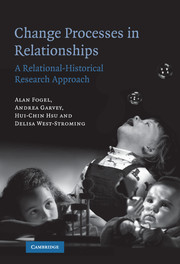Book contents
- Frontmatter
- Contents
- List of figures
- List of tables
- Acknowledgments
- Prologue Overview of the research problem and summary of findings
- 1 Relationships as developing systems: theoretical foundations
- 2 Mother-infant relationship development in the first six months: from face-to-face play to object play
- 3 Relational-historical research on developmental change
- 4 Relational-historical research: the multiple case study approach, frame analysis, qualitative and quantitative analysis
- 5 Research propositions about relationship change processes
- 6 Research methods for the current investigation: subjects, procedures, and data analysis
- 7 Results of the current investigation: quantitative analysis of developmental changes in relationship frames and in infant actions
- 8 Results of the current investigation: qualitative analysis of Richard and his mother
- 9 Results of the current investigation: qualitative analysis of Betsy and her mother
- 10 Results of the current investigation: qualitative analysis of Lewis and his mother
- 11 Results of the current investigation: qualitative analysis of Susan and her mother
- 12 Summary of findings on relational-historical change
- Epilogue Laws of change: implications for theory and practice
- References
- Author index
- Subject index
12 - Summary of findings on relational-historical change
Published online by Cambridge University Press: 22 September 2009
- Frontmatter
- Contents
- List of figures
- List of tables
- Acknowledgments
- Prologue Overview of the research problem and summary of findings
- 1 Relationships as developing systems: theoretical foundations
- 2 Mother-infant relationship development in the first six months: from face-to-face play to object play
- 3 Relational-historical research on developmental change
- 4 Relational-historical research: the multiple case study approach, frame analysis, qualitative and quantitative analysis
- 5 Research propositions about relationship change processes
- 6 Research methods for the current investigation: subjects, procedures, and data analysis
- 7 Results of the current investigation: quantitative analysis of developmental changes in relationship frames and in infant actions
- 8 Results of the current investigation: qualitative analysis of Richard and his mother
- 9 Results of the current investigation: qualitative analysis of Betsy and her mother
- 10 Results of the current investigation: qualitative analysis of Lewis and his mother
- 11 Results of the current investigation: qualitative analysis of Susan and her mother
- 12 Summary of findings on relational-historical change
- Epilogue Laws of change: implications for theory and practice
- References
- Author index
- Subject index
Summary
In this chapter, we summarize the findings of our quantitative and qualitative analysis of thirteen mother-infant dyads, observed weekly during free play with toy objects, across the developmental transition that marks the emergence of mother-infant-object play. In addition, we discuss the limitations and possibilities for the research methods used here. In the first section of this chapter we summarize the findings on the research propositions about the development of frames and transitions. In the second section, we address the propositions about the development of infant actions as they relate to frame development. In the third section, we address the limitations of our study.
Each of the different methods used – statistical modeling of developmental trajectories and their covariates in infant action, and the quantitative and qualitative analysis of four representative dyads – give different views on the process of developmental change. The quantitative analysis is developmental in the sense that we model the shape of developmental trajectories within dyads over twelve weekly observation sessions. The qualitative analysis is historical because it examines particular successions of events through time in order to understand how developed actions grow from their earlier forms and how these project themselves towards possible future pathways. Our approach is called relational-historical because, in addition to developmental analysis, we study historical process in the context of a developing relationship. The relationship – the unfolding of communication patterns over time – is the focus of the analysis rather than the individual infant.
Information
- Type
- Chapter
- Information
- Change Processes in RelationshipsA Relational-Historical Research Approach, pp. 209 - 229Publisher: Cambridge University PressPrint publication year: 2006
